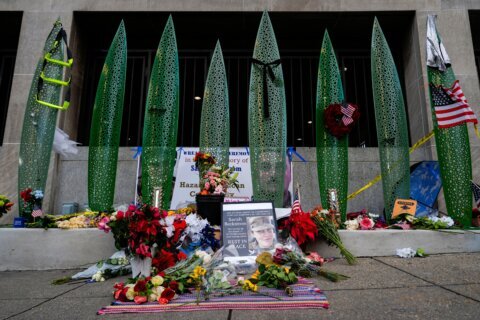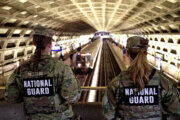BANGOR, Wash. – It’s a cool, crisp, bright, sunny, late July morning on the Puget Sound in Washington State. Chatter and song burst forth from seahawks and other wildlife nestled in the spacious, pristine landscape and waterways during the drive to Keyport.
After a left turn into a heavily guarded, long, broad driveway, bustling with entering and exiting vehicles, nature’s symphony gradually fades.
It blends into the dull din of gigantic cranes, scurrying military vehicles and the beeping sounds of heavy construction vehicles moving around. Tall, majestic hemlock trees and the rest of nature’s picture-perfect mosaic form the backdrop for a tapestry of numbered buildings and uniforms. A large sign reads “Welcome to Naval Base Kitsap Bangor.”
Navy Chief Mass Communications Specialist Ahron Arendes leads the way as we enter the high security zone.
Transiting a confusing array of turns, Arendes says, “Right, now we’re in the middle of Delta pier, walking to the north part of the pier where the USS Maine, Ballistic Missile submarine is moored.”
After a short walk, the Maine came into view, sitting quietly in the cold, dark, deep waters of the Hood Canal.
Rocking slightly, with water lapping gently at the sides, the submarine’s docile disposition should not be mistaken for just any another U.S. naval vessel.
The USS Maine is an Ohio Class Nuclear Submarine (SSBN) — a combination of tactical superlatives, weapons prowess and secrecy. It’s a virtually undetectable undersea launch platform for intercontinental ballistic missiles (ICBMs). The vessel has two crews, a blue crew and a gold crew, that alternate turns on patrols. Each crew is deployed for up to 180 days per year. While one crew is on patrol, the other is on leave before deploying on its subsequent patrol.
Stealth is its biggest asset.
“We are given vast swaths of the Pacific Ocean to operate. Even our bosses don’t know exactly where we are,” says Commander Richard Massie, captain of the USS Maine (gold crew).
While their location is a mystery to their chain of command, they are never more than a whisper away from the commander-in-chief of the United States.
When the Maine deploys, “We disappear. This submarine is extremely quiet as are all Ohio Class submarines. We’re very difficult to find, yet we can maintain communications with the national command authority and with the President of the United States. If he were to choose to do so, we would be ready to conduct a strike against an adversary,” says Massie.
If called upon to launch a strike, it has what some experts have called the most credible strategic deterrent in the history of the planet.
“We have the capability to carry 24 Trident II D-5 Ballistic missiles,” says Massie. “Each of those missiles has the capability to have multiple reentry bodies.”
That means, each ballistic missile payload contains several warheads, each capable of hitting one of a group of targets.
“It is one of fourteen SSBNs in our fleet that join strategic bombers and ICBMs to form the three legs of our nation’s Nuclear Triad. SSBNs are the most survivable leg of the Triad because when they are submerged they are undetectable, and thus not locatable and not targetable,” says Commander William Johnson, captain of the USS MAINE (blue crew).
Their No. 1 mission, according to Massie, is to provide “survivable second strike” capability for the U.S. survivability is the key, because “if someone were fool- hardy enough to attack the United States, we have land-based deterrent, we have air-based deterrent, but we are the survivable leg of the triad,” he says.
Naval officials say when they test the Trident II D-5, they know it works and “so do our adversaries.”
“Our SSBNs provide approximately 70 percent of our nation’s total deterrent force and have demonstrated an impeccable record of success over the past 50 years,” Johnson says.
The USS Maine, like other Ohio Class Ballistic Missile submarines when deployed, carries a nuclear weapons payload which compares to that of the world’s fifth most powerful nuclear country.
Related Story:
Editor’s note: This story is part of an eight-part series on the USS Maine submarine. WTOP’s J.J. Green visited the crew of the USS Maine in late July in the Seattle, Wa., area.
Follow @WTOP on Twitter.







